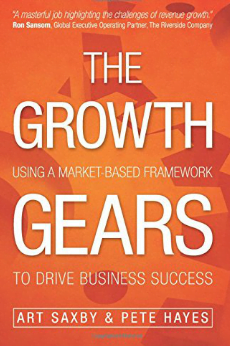
As pointed out in several books (including “The Three-Box Solution” and “The 7 Irrefutable Rules of Small Business Growth“), managing a business and growing a business require two different mindsets. Just because a business is first-class in its product or service doesn’t mean it will be around tomorrow (i.e. Netflix, Kodak, etc.)
Many business owners recognize that they need to step it up for their businesses to get started, but they are confused about how to get started.
How do you grow your business in this environment when the only thing you know is your business?
What is The Growth Gears About?
The Growth Gears: Using A Market-Based Framework To Drive Business Success attempts to solve a problem that many owners face: They can’t see outside their business to grow.
The reason the book argues that many business owners have this problem is because they are operationally minded, one of two camps that The Growth Gears says owners fall into. Operationally-minded owners know how to run a good business. They are tinkerers who know how to refine their business process, strategies and personnel to satisfy their current customers.
The downside to being operationally-minded is that you can get so focused on the present that you lose sight of the future.
That’s where the marketing-minded owner comes in. The marketing-minded owner is geared toward growth. This kind of owner knows their current customers in the present and keeps their eyes on the future. They are the owners who are able to transform business process, insight from customer data and signals from the future into a business that successfully evolves through an uncertain future.
The downside to being a marketing-minded owner is that you’re so focused on the future that you can lose your business in the present.
Combining these two mindsets (operation-focused vs marketing-focused) is the goal of The Growth Gears. The authors suggest that businesses that run well today but stay prepared for the future will be in the best position to survive. The way to obtain this mindset is to develop the “three gears” of a marketing-focus business explained in the book while staying operationally fit in the present.
Author Art Saxby is a finance guy who decided to try marketing. His venture into marketing turned into a successful career working for companies like Frito-Lay, Coca-Cola and Kellogg’s. He also co-founded Chief Outsiders, a “rent-an-executive” agency with co-author Peter Hayes.
Hayes is an engineer with experience working for agencies that provided service to companies like Dell, Motorola, and 3M before co-founding Chief Outsiders with Saxby.
What Was Best About The Growth Gears?
The best part of The Growth Gears is the simplicity. Saxby and Hayes refine the complexity of business growth and development into just two mindsets. Using those mindsets, they apply a simple 3-process model and then demonstrate how this model can be applied to some of the toughest questions that business owners have (Should we lower our price? What do we need to know about our competitors? etc.) using direct and easy-to-understand examples.
What Could Have Been Done Differently
The Growth Gears is packed with helpful advice that can help any business owner (although it is aimed at owners and upper-level executives like CEOs, CMOs, etc.) to think further about the conditions surrounding their business. The one area that could benefit from more attention is the book’s section on assessments. The assessments (especially the first) lack the level of detail that can be found in the content.
Why Read The Growth Gears?
The Growth Gears is a great book recommendation for any business owner who wants to improve their SWOT analysis but wants another perspective. Saxby and Hayes draw on their years of experience of fixing and growing businesses (Both authors have experience growing businesses from millions to billions.) to present a simple model (“three gears”) and easy-to-understand examples that can be used and reused to supplement other forms of business planning.
If you have ever been in the situation of having a good business but you’re planning to grow it more, this book offers a perspective that is definitely worth looking into.
[“source-smallbiztrends”]




